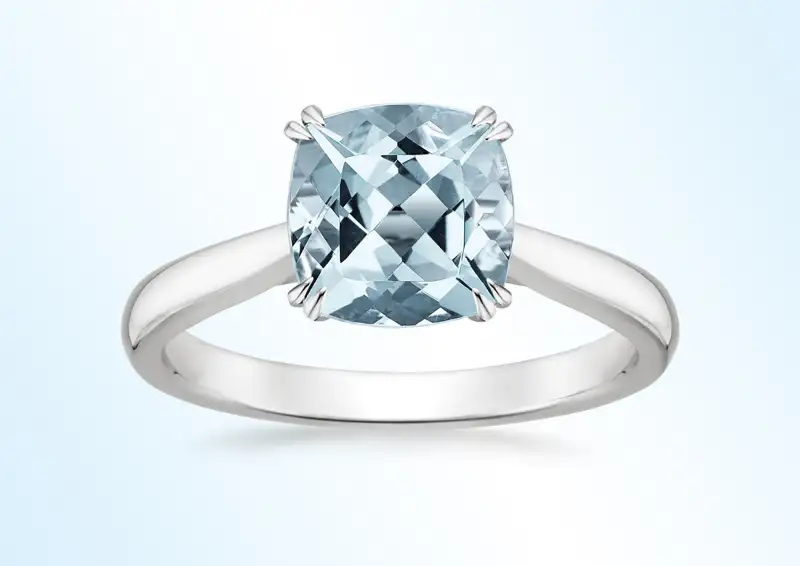7 Classy Alternatives to Expensive Diamond Engagement Rings

If a marriage proposal is on your mind right now, you're not alone; one in three engagements takes place between Thanksgiving and New Years.
It's no coincidence that this same season is the biggest for diamond ring sales. At least among straight couples, the act of getting hitched tends to follow a very specific script: A man gets down on bended knee and offers a ring that costs (on average) more than $5,800, or nearly two months' salary. That ring is almost always set with a diamond.
What might come as a surprise to many couples is that this familiar engagement tradition is not much of a tradition at all. Before World War II, only 10% of proposals involved diamond engagement rings; that number skyrocketed to 80% by 1990 for a couple of reasons, neither of which is particularly romantic.
One factor was the rise in demand for expensive rings as collateral against broken engagements, after states began banning so-called "breach of promise to marry" lawsuits in the 1930s. Jilted women had previously been able to sue former fiancés for damages to their reputations and future marriage prospects, since premarital sex was increasingly common among engaged couples—but women were still valued for their chastity. Once the bans eliminated that option, rings began to serve as a sort of "virginity insurance."
The other key force behind today's demand for diamond rings is De Beers, the cartel that has spent the last century artificially limiting supply while inventing a "tradition" through brilliantly manipulative marketing. That two months' salary rule? Thank a 1980s De Beers ad campaign. The saying, now being revived for millennial buyers, "a diamond is forever"? That was the brainchild of a De Beers adwoman in 1947 (and one reason why diamonds have terrible resale value).
If these aren't enough reasons to think twice about diamonds, there's also the fact that—because of loopholes in an international agreement to ban conflict stones—the mined diamond industry today continues to fuel violence and employ child labor in developing nations. Even if you try your hardest, it's difficult to know for certain that your "conflict free" gem hasn't indirectly contributed to murder, rape, or enslavement.
Now, the idea of breaking with custom—however tenuous its origins—may concern you. Fear not: There are plenty of romantic, classy alternatives to the "traditional" diamond engagement ring, many of which offer greater value and far less cause for guilt. Here are seven great options to consider.
Man-Made Diamonds
White diamonds that have been grown in a laboratory typically cost 15% to 20% less than comparable natural diamonds, though the discount might be much higher or lower, depending on the size of the stone and where you're buying. And colored lab-made diamonds can be a whopping 80% or 90% cheaper than their mined equivalents.
De Beers and other natural diamond purveyors regard synthetic diamonds as a threat to their business and have been very successful in selling the public on the idea that a "real" diamond must come from the earth.
The fact that mined diamonds are literally millions (and sometimes billions) of years old is certainly romantic. But it is incorrect to call a lab-grown diamond "fake." Man-made diamonds are physically and chemically identical to natural diamonds. The higher price tags on mined diamonds have more to do with sentiment and clever marketing than intrinsic value.
Another bonus? Cultured diamonds also have less negative impact on the environment. Replacing one diamond mine's annual production with man-made gems would eliminate the equivalent of more than 480 million miles' worth of car emissions.
Moissanite
Cubic zirconia and other diamond "simulants" have a bad rap, in part because they are easily dulled and scratched and won't stay perpetually shiny like a real diamond, one of the hardest substances on earth.
Enter moissanite, a crystal that naturally occurs in meteorites, is nearly as hard, dense and scuff-resistant as a diamond, and actually has greater brilliance and fire (gemologist jargon for sparkle and light-dispersion). Originally discovered in the late 1800s, moissanite is now produced in the laboratory for a fraction of the cost of even lab-made diamonds.
While a perfect, colorless two-carat diamond will cost you upwards of $40,000—and an imperfect one-carat diamond can still set you back nearly $10,000—a nearly flawless one-carat moissanite gem costs less than $1,000. And thanks to recent innovations in the way they are made, moissanite stones are tough to distinguish from natural diamonds, even for experts.
Other Precious Gems
Here's another piece of evidence that there's little rhyme or reason to the pricing of diamonds: Even though tanzanite is one of the rarest gems on earth (1,000 times rarer than diamonds) a tanzanite stone can cost nearly 10 times less than a comparable diamond.
And many other gems that are rarer than diamonds, including rubies, emeralds, and sapphires, are still less expensive. Even a vivid, well-cut one-carat blue sapphire need not set you back more than a couple thousand dollars.
If you'd prefer a colorless stone (for that "traditional" engagement ring look), a white sapphire is actually even cheaper than a blue one, despite being rarer.
A Truly Traditional Ring
If you want to offer an engagement ring with real cultural significance and history, skip the diamond and instead consider proposing with a truly traditional piece of jewelry.
One such example is the Claddagh ring, a betrothal symbol dating back to seventeenth-century Ireland that features two hands holding a heart topped with a crown (representing friendship, love, and loyalty).
According to custom, the heart is worn pointing away on the right hand if the wearer is single and toward the body when the wearer has a love interest; on the left hand, it should point away if the wearer is engaged and toward the body once the wearer is married.
Another band with traditional meaning is the "true lover's knot," an ornamental (and difficult-to-untangle) knot once tied by sailors separated from their beloved.
Travel
A great deal of evidence shows that spending money on experiences tends to generate more happiness than spending the equivalent amount on material things.
In other words, you might considering buying an inexpensive engagement ring—or skipping the ring altogether—so you can, say, drop your savings into a one-year CD that will come to term right in time for your honeymoon.
If you think a diamond sounds romantic, how about an all-expenses-covered trip to Bali?
A House
To take that logic a step further, what's more romantic than an investment in your future as a couple—like a down payment on a home?
Before you groan and roll your eyes, know this: The very first engagement rings actually served as "tags," so men could mark their wives as property in the ancient world. Talk about a mood-killer.
Instead of an occasion for spending hard-earned cash on an arguably sexist, outdated symbol, your engagement could be a moment when you make a real commitment toward your life together. And there are worse times than today to make such a forward-thinking move, what with interest rates so low.
A DIY Ring
The processes for making synthetic diamonds are getting easier every year, with increasingly mundane-sounding tools and ingredients: Think microwaves and peanut butter.
But (despite wishful thinking on the internet) unless you've got 10 weeks and an industrial-strength oven capable of superheating gas to hundreds of degrees Celsius, you will probably have a tough time re-creating the lab conditions needed to make a diamond at home.
Don't worry, you can always make another type of DIY ring. One idea? Weave the tiniest gemstone beads you can find into a buckyball, which is basically a diamond for nerds.
After all, there's nothing classier than making an engagement ring with your own two hands.
